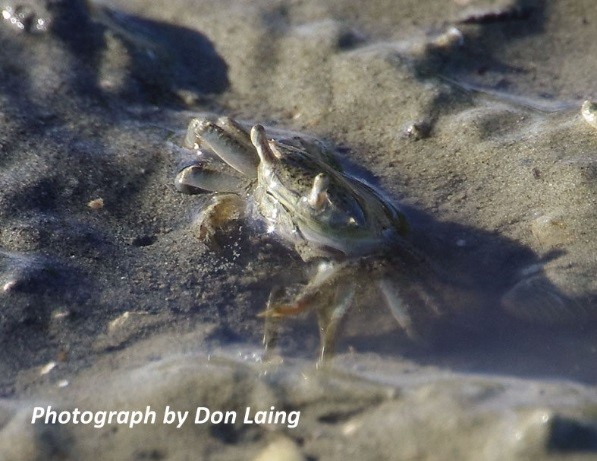Tunnelling Mudcrab
If you take a walk through the Wildlife Reserve at Pāuatahanui Village and head out toward the hides you will come to the upper intertidal region where the estuary is regularly covered by the tide but still exposed to air for more than six hours on each tidal cycle.
In the mud at the side of the track you will see what look like the entrances to tunnels and you may wonder what produced these features. The answer is Austrohelice crassa, the tunnelling mud crab; and indeed, tunnels are exactly what they are.
The olive-green tunnelling mud crab has an almost square carapace and two short-stalked eyes, and is found in large numbers on healthy mud flats. It digs elaborate tunnels in the mud, often with more than one entrance.

Active by day, tunnelling mud crabs eat the tiny living organisms (diatoms, algae and bacteria) that grow profusely in this rich and often warm, sunlit, environment. Food is extracted from the mud which is scooped up with flat, spade-like, chelipeds (nippers) and carried into the mouth. The material is sorted by its mouthparts to separate the micro-organisms, which are eaten, and the sediment which is wiped away by the chelipeds to form pellets which can be seen on the surface of the mud. An area only the size of a hand is sufficient to feed a mud crab for life.
A. crassa individuals sleep in their burrows at night and often plug the entrance with mud to keep out intruders. During the day this crab will seldom move far as it must return frequently to its burrow to wet its gills. It will defend the burrow against intruders and may adopt a threatening posture if in danger; but it is also very wary and will scuttle away at the slightest movement.
When out of the burrow it is easy prey for many of the Inlet’s wading shore birds (e.g. oystercatcher and spoonbill) as well as black-backed gull and kingfisher. It is also eaten by various estuarine fish like parore, cod, flounder and yellow-eyed mullet, so usually returns to its burrow when the tide is in.
These crabs mate between May and August and the female lays up to 16,000 eggs which take 42 days to incubate. Living in the estuary they can be exposed to wide ranges of temperature and salinity and both immature and adult crabs are admirably adapted to survive these extreme conditions.